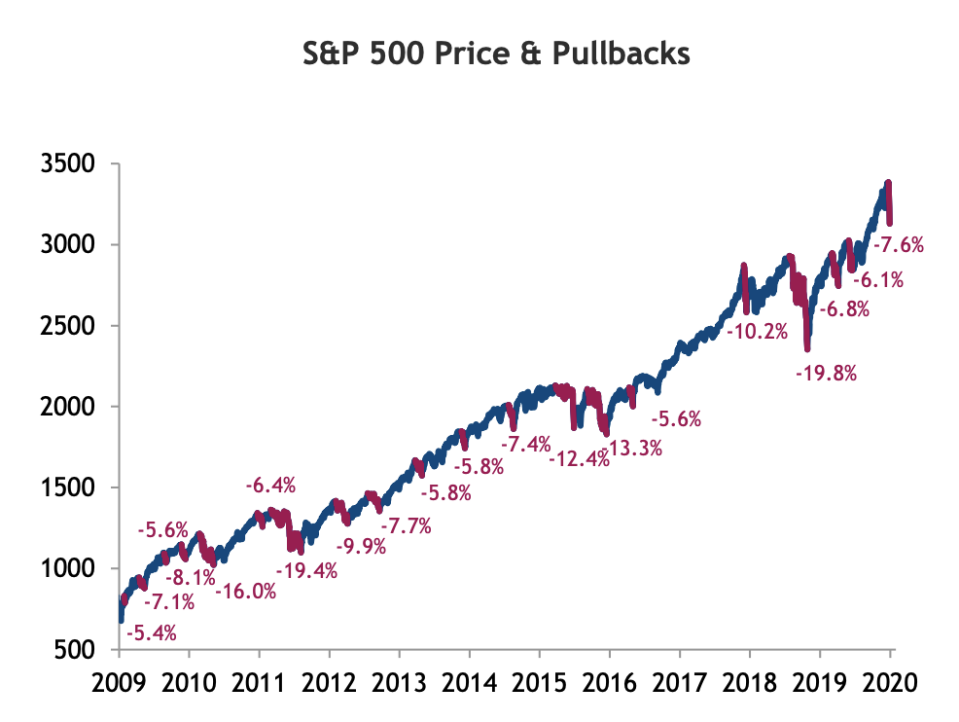Coronavirus has ravaged the stock market and the extreme selling may just be starting
Proceed with caution, value-seeking investors. The hammer job done on stocks at the hands of the spreading coronavirus may just be getting started if history and common sense are any guides.
SunTrust chief markets strategist Keith Lerner thinks there is another 5% to 7% of downside possible for the S&P 500. His call is supported by two factors.
The first is a heavy dose of market history. Lerner notes that since the current bull market began in March 2009 (S&P 500 up 400% since then) there have been 19 pullbacks of at least 5%. Every pullback came with uncertainty and bad news, Lerner says, pointing to several virus-related outbreaks such as the Swine flu in 2009, the Ebola scare in 2014 and Zika in 2016. These corrective periods have lasted an average of 47 days and have seen an average pullback of 9.4%.
The current correction spurred by fears of the coronavirus morphing into a global pandemic — where $2.5 trillion has been wiped off the value of U.S. stocks since last Wednesday’s high per S&P data — is approaching the average bull market percentage pullback. But the losses have come in only four days and there remains significant uncertainty as to how bad Corporate America’s profits will be hit.
Trust me, I talk to loads of top executives — off the record they are saying it’s hard to even estimate the impact not only in the first quarter, but into the summer. But you could hear the concern in their voices.
That uncertainty and financial risk has to get priced into stocks. It likely will as infection and death tolls from coronavirus stand to rise globally in the weeks ahead.

Several sources on the Street have also told me the extreme selling this week — which has approached 2,000 points on the Dow Jones Industrial Average in two days — has been fueled mostly by hedge fund selling. These are the algo driven hedgies that have plowed into bull market momentum names such as Advanced Micro Devices, Amazon, Netflix, you name it. The next shoe to drop in markets could be institutions lightening the load on equities — both growth and value — amid a material reassessment of the coronavirus-related risk factors.
Up to this point, said long-term minded institutions have stayed upbeat on the markets on the view the coronavirus impact would be isolated to the first quarter. Perhaps some negatives in the second quarter, but by the back half of the year it would be in the rearview mirror. Definitely no 2020 impact, in their view.
“We’d also highlight that although sentiment has become less bullish, it has not fallen very much at all,” says Miller Tabak strategist Matt Maley. “For instance, the Investor’s Intelligence data showed that bullishness had only fallen from 54.7% to 49.1% and the spread between bulls & bears was still at 29.9%. Therefore we’re a long way from seeing this reading move to a bearish plurality…which would be a much more bullish sign for the intermediate/long-term prospects for the stock market.”
A folly view by institutions, as they are beginning to realize.
The upside right now? The nearly 11-year bull market in stocks is unlikely dead.
“Even though this pullback has been fierce, it’s not necessarily unusual following the sharp gains we had seen or in the context of this bull market,” says Lerner. “Such pullbacks, while always uncomfortable, are the admission price to the stock market and participating in the potential for higher returns over time.”
Brian Sozzi is an editor-at-large and co-anchor of The First Trade at Yahoo Finance. Watch The First Trade each day here at 9:00 a.m. ET or on Verizon FIOS channel 604. Follow Sozzi on Twitter @BrianSozzi and on LinkedIn.
Read the latest financial and business news from Yahoo Finance
Beyond Meat founder: things are going very well with McDonald’s
Starbucks CEO on what China has in store for the coffee giant
Follow Yahoo Finance on Twitter, Facebook, Instagram, Flipboard, SmartNews, LinkedIn, YouTube, and reddit.
